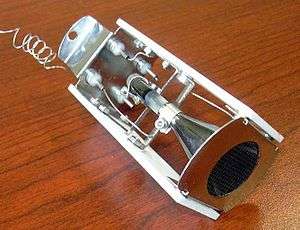Electron multiplier

An electron multiplier is a vacuum-tube structure that multiplies incident charges.[1] In a process called secondary emission, a single electron can, when bombarded on secondary emissive material, induce emission of roughly 1 to 3 electrons. If an electric potential is applied between this metal plate and yet another, the emitted electrons will accelerate to the next metal plate and induce secondary emission of still more electrons. This can be repeated a number of times, resulting in a large shower of electrons all collected by a metal anode, all having been triggered by just one.
Operation
The avalanche can be triggered by any charged particle hitting the starting electrode with sufficient energy to cause secondary emission.[2] Hence the electron multiplier is often used as an ion detector. It could also be triggered by a photon causing vacuum photoemission of at least one electron. In a photomultiplier tube, a photo-emissive surface is followed by an electron multiplier with several sequential multiplying electrodes called dynodes. Because these electrodes are separate from each other, this might be called a "discrete-dynode" multiplier. A voltage divider chain of resistors is usually used to place each dynode at a potential 100-200V more positive than the previous one.

A "continuous-dynode" structure is feasible if the material of the electrodes has a high resistance so that the functions of secondary-emission and voltage-division are merged.[3] This is often built as a funnel of glass coated inside with a thin film of semi-conducting material, with negative high voltage applied at the wider input end, and positive voltage near ground applied at the narrower output end. Electrons emitted at any point are accelerated a modest distance down the funnel before impacting the surface, perhaps on the opposite side of the funnel. At the destination end a separate electrode (anode) remains necessary to collect the multiplied electrons. This structure is also known as (single) channel electron multiplier (CEM) or continuous channel multiplier, and one of the most common is sold under the trade name Bendix Channeltron.
Another geometry of continuous-dynode electron multiplier is called the microchannel plate.[4][5] It may be considered a 2-dimensional parallel array of very small continuous-dynode electron multipliers, built together and powered in parallel too. Each microchannel is generally parallel-walled, not tapered or funnel-like.
Applications
In mass spectrometry electron multipliers are often used as a detector of ions that have been separated by a mass analyzer of some sort. They can be of the continuous-dynode type, and may have a curved horn-like funnel shape, or they can have discrete dynodes as in a photomultiplier.
See also
- Faraday cup
- Daly detector
- Phototube
- Photo-multiplier tube
- Scintillation counter
- Lucas cell
- Zoltán Lajos Bay (developer)
References
- ↑ Allen, James S. (1947), "An Improved Electron Multiplier Particle Counter", Review of Scientific Instruments, 18 (10): 739, Bibcode:1947RScI...18..739A, doi:10.1063/1.1740838
- ↑ Allen, James (1939), "The Detection of Single Positive Ions, Electrons and Photons by a Secondary Electron Multiplier", Physical Review, 55 (10): 966, Bibcode:1939PhRv...55..966A, doi:10.1103/PhysRev.55.966
- ↑ Heroux, L.; Hinteregger, H. E. (1960), "Resistance Strip Magnetic Photomultiplier for the Extreme Ultraviolet", Review of Scientific Instruments, 31 (3): 280, Bibcode:1960RScI...31..280H, doi:10.1063/1.1716957
- ↑ Burroughs, E. G. (1969), "Collection Efficiency of Continuous Dynode Electron Multiple Arrays", Review of Scientific Instruments, 40: 35, Bibcode:1969RScI...40...35B, doi:10.1063/1.1683743
- ↑ Ladislas Wiza, J (1979), "Microchannel plate detectors", Nuclear Instruments and Methods, 162: 587, Bibcode:1979NucIM.162..587L, doi:10.1016/0029-554X(79)90734-1